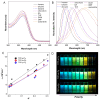Engineering Isomeric AIEgens Containing Tetraphenylpyrazine for Dual Memory Storage
- PMID: 39474482
- PMCID: PMC11503880
- DOI: 10.1021/cbmi.3c00048
Engineering Isomeric AIEgens Containing Tetraphenylpyrazine for Dual Memory Storage
Abstract
Tetraphenylpyrazine (TPP) is a promising heterocycle-based aggregation-induced emission luminogen (AIEgen) which has sparked multiple applications in organic light-emitting diodes, sensors, and biotherapy. However, the utility of it in developing information storage materials is relatively rare. Moreover, TPP is mostly employed as an electronic acceptor in molecular design, while the consideration of it as an electronic donor is attractive in studies which may provide a full understanding of its property to tailor the materials. In this work, we synthesize three TPP-based molecules by decorating it with acrylonitrile and isomeric pyridine units, which show AIE behavior by property inheritance from their parent unit. Interestingly, the effective intramolecular charge transfer takes place from the TPP electronic donor to the acrylonitrile and pyridine electronic acceptor, therefore inducing a remarkable solvatochromic effect as the solvent polarity improves. Moreover, it is revealed that the isomeric effect of the nitrogen atom in the pyridines may pose an influence on the absorption, solvatochromism, and AIE behavior. In addition, the acrylonitrile and pyridine groups are reactive to light and acid-base stimuli with irreversible and reversible responses, respectively. Combined with the high light-harvesting ability of these AIEgens, they show great potential in the stimuli-responsive materials for dual information storage.
© 2023 The Authors. Co-published by Nanjing University and American Chemical Society.
Conflict of interest statement
The authors declare no competing financial interest.
Figures








Similar articles
-
Tetraphenylpyrazine-based AIEgens: facile preparation and tunable light emission.Chem Sci. 2015 Mar 1;6(3):1932-1937. doi: 10.1039/c4sc03365e. Epub 2014 Dec 11. Chem Sci. 2015. PMID: 28717453 Free PMC article.
-
A Type of Atypical AIEgen Used for One-Photon/Two-Photon Targeted Imaging in Live Cells.ACS Appl Bio Mater. 2020 Jan 21;3(1):505-511. doi: 10.1021/acsabm.9b00946. Epub 2020 Jan 6. ACS Appl Bio Mater. 2020. PMID: 35019467
-
Chiral assembly of organic luminogens with aggregation-induced emission.Chem Sci. 2021 Jun 10;13(3):611-632. doi: 10.1039/d1sc02305e. eCollection 2022 Jan 19. Chem Sci. 2021. PMID: 35173927 Free PMC article. Review.
-
Full Color Tunable Aggregation-Induced Emission Luminogen for Bioimaging Based on an Indolizine Molecular Framework.Bioconjug Chem. 2020 Nov 18;31(11):2522-2532. doi: 10.1021/acs.bioconjchem.0c00467. Epub 2020 Oct 8. Bioconjug Chem. 2020. PMID: 32985867
-
Bringing Inherent Charges into Aggregation-Induced Emission Research.Acc Chem Res. 2022 Jan 18;55(2):197-208. doi: 10.1021/acs.accounts.1c00630. Epub 2022 Jan 5. Acc Chem Res. 2022. PMID: 34985255 Review.
References
-
- Lou K.; Hu Z.; Zhang H.; Li Q.; Ji X. Information Storage Based on Stimuli-Responsive Fluorescent 3D Code Materials. Adv. Funct. Mater. 2022, 32, 2113274.10.1002/adfm.202113274. - DOI
-
- Le X.-X.; Lu W.; He J.; Serpe M. J.; Zhang J.-W.; Chen T. Ionoprinting controlled information storage of fluorescent hydrogel for hierarchical and multi-dimensional decryption. Sci. China Mater. 2019, 62, 831–839. 10.1007/s40843-018-9372-2. - DOI
-
- Wang H.; Ji X.; Page Z. A.; Sessler J. L. Fluorescent materials-based information storage. Mater. Chem. Front. 2020, 4, 1024–1039. 10.1039/C9QM00607A. - DOI
LinkOut - more resources
Full Text Sources
